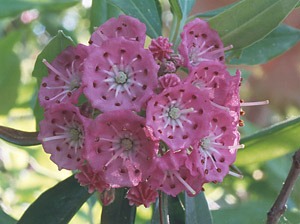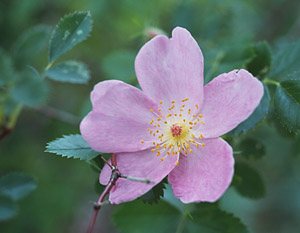
Sheep Laurel, Heath family (Ericaceae), Native

 |

The dark pink, cup-like flowers appear in clusters. As the photo shows, each flower has ten stamens
tipped with pollen-bearing anthers that are tucked into pockets in the flower petals. When an insect
pokes at the center of a flower, the stamens spring out of the pockets, sprinkling pollen on the
insect.
Nodding Trillium, Lily family (Liliaceae), Native
Pasture or Carolina Rose, Rose Family (Rosaceae), Native

|
Just as mid-June is the time for roses in Westborough's gardens, so it is at the Reservoir. In wooded areas near the water, especially on peninsulas, wild pink roses such as pasture rose (Rosa carolina) bloom and perfume the warm air with their delicate fragrance. The petals are fragrant even after they have fallen from the blossoms.
The fruits, or rose hips, develop through the summer and turn reddish in the fall, lasting on the bushes
into the winter. Roses have long provided food, going back to the Native Americans. Rose hips are
rich in vitamin C. They have been made into jam, tea, and candy.
| show TOC frame | Table of Contents | 
|
| Home / Contact | ||
Copyright © Anne A. Reid, 1999-2002. Photographs copyright © Garry K. Kessler, 1999-2002. | ||